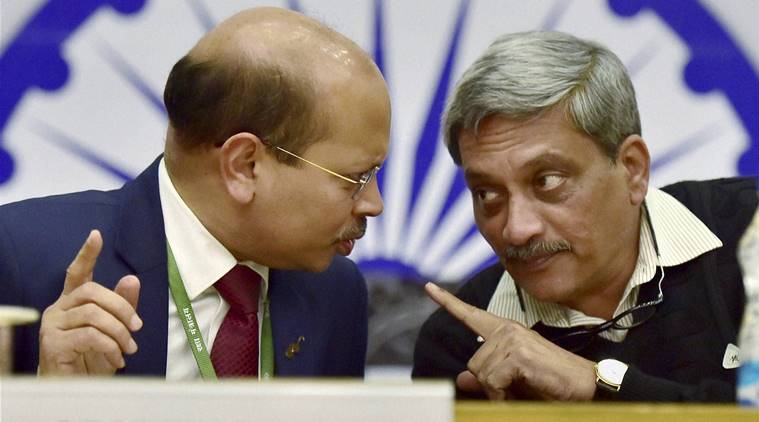- India
- International
India’s new Defence Procurement Procedure: Why it is revolutionary
It will require extraordinary amount of will power and dedication on the part of the government to stay on course. But the rewards will be staggering.
 Defence Minister Manohar Parrikar talks with Ashok Kumar Gupta, Secretary, Defence Production. PTI Photo
Defence Minister Manohar Parrikar talks with Ashok Kumar Gupta, Secretary, Defence Production. PTI Photo
A few weeks ago, key provisions of the new Defence Procurement Procedure (DPP) were announced. But the most important provision that got scarce attention from the media was pertaining to the introduction of the new category called Buy Indian (Indigenously Designed, Developed and Manufactured – IDDM). This category would have the highest priority, meaning, if there is a product that is designed and developed in India, then foreign/Indian vendors cannot participate in the said tender.
For the past couple of decades India has been stating that we are importing 70 per cent of the defence equipment and indigenously producing the rest of 30 per cent. And our target has been to flip that ratio. But it has remained so for the past two decades because of the lopsided policy that we had. Till now, the most preferred category in defence has been Buy Indian with 30 per cent indigenous content (IC). There is no category that encourages design, which is actually the most important and value capturing aspect of any equipment. For example, in sale price of Apple iPhone 6, the bill of material is $200 and the gross margin is round $450. And the major part of this gross margin is attributable to design and development of the product. Foxconn which manufactures iPhone, barely makes any money – may be two per cent to three per cent per piece. Seventy to eighty per cent of the value is captured by the company which owns the IP of the product.
[related-post]
As there is no incentive to the products which are 100 per cent designed in India, the foreign OEMs and their Indian “partners” would restrict the content to 30 per cent. With almost no proper monitoring, this category had become a joke. In the US, for example, they give price preference for American manufactured defence items. With no such preference to the Indian designed product from the only customer (Indian defence), any company which was foolhardy to design its own defence equipment was strategically under quoted by foreign companies. Since L1 was the only criteria in defence procurement till now, in most cases, the Indian company and the design would die in no time.
For the first time in the history of Indian defence procurement the importance of design and development has been recognised by Ministry of Defence. This category is going to ensure huge inflow of funds into research and development and will ensure that the scientific talent in India is engaged in developing cutting edge technologies in Defence. With such huge investments, going into R&D, India, from being a destination for outdated defence equipment, will become the source for cutting-edge technology in defence.
Is anything still lacking in this all important IDDM category. I feel that percentage of the IC should have been higher at 75 per cent or so. If there is no firm that can offer such high content, on a case to case basis, they should have decreased the requirement. Alternatively, they could have considered giving price preference of two per cent for every five per cent of increased indigenisation over and above the mandated 40 per cent.
Call to kill this category:
Effort to scuttle this category will definitely be there. We are already hearing a whisper campaign against the category, mostly initiated by foreign OEMs but being pushed by some Indian vendors. Vested interests will try to kill/derail/delay the category so that the status quo is maintained. It will require extraordinary amount of will power and dedication on the part of the government to stay on course. But the rewards will be staggering.
How to Calculate the Indigenous Content:
The way to implement it, is to calculate the indigenous design content by looking at the bill of materials. All imported content, no matter how far removed is the import, should be eliminated and only indigenous content should be considered. To determine whether a product is indigenous we need to ensure that the IP content of the product is owned by Indian Industry. It is easy to check ownership of the software by looking at the code compiled with some test changes; ownership of the mechanical and electronic designs can also be checked at looking at the drawings, circuit diagrams and firmware. When design ownership is there, it should not involve any outflow of money due to royalty payments. When design ownership is partial it should be not included in this category but should be shunted to Buy Indian category. Such simple steps will ensure that this category is successful.

Another cause of confusion, is mixing the 60 per cent IC in the design category. It should have been Buy Indian (60 per cent IC) category and should not have been clubbed with the all-sacred IDDM category as there is no “design” or “development” in pure manufacturing. To treat a company that has designed the product with the company that is purely manufacturing the product is a bit mystifying.
Severe penalty for abusing the IDDM category:
The government needs to ensure that the punishment for wrongly claiming design ownership or falsely stating more IC is very severe including holding of any unpaid money, disgorgement of any payments already made, criminal liability to include the top management and the board of directors. Only such severe punishments will deter companies from abusing this very sacred category.
In conclusion, this is really a path-breaking DPP and needs to be hailed as a big breakthrough. However, serious efforts will be made by foreign OEMs and their proxies to discredit this category (Good intention, but difficult to implement, etc.). Beware the traitor who denigrates this category with specious arguments. Indian Govt and Indian R&D companies should work hard to make this category a big success and ensure that India becomes a hub for creating cutting-edge technologies in defence.
Apr 25: Latest News
- 01
- 02
- 03
- 04
- 05








































